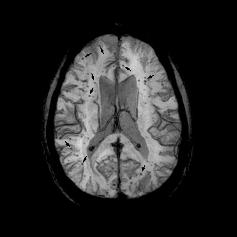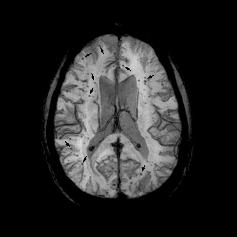
Credit: UCI School of Medicine
Irvine, Calif. – September 25, 2018 – A team of researchers including UCI project scientist Rachita Sumbria, PhD and UCI neurologist Mark J. Fisher, MD have provided, for the first time, evidence that blood deposits in the brain may not require a blood vessel tear. The researchers found that brain endothelial cells, the cells that line blood vessels of the brain, have the capacity for engulfing red blood cells and depositing them outside the blood vessels and into the substance of the brain, without requiring a disruption of the vasculature.
"It has long been believed that a tear or rupture of a brain blood vessel is the cause of cerebral microbleeds," said Fisher, a professor of neurology at the UCI School of Medicine. "While more confirmatory work needs to be done, our study points to an entirely new direction in efforts to eliminate brain bleeding and its consequences."
The study, titled, "Brain Endothelial Erythrophagocytosis and Hemoglobin Transmigration Across brain Endothelium: Implications for Pathogenesis of Cerebral Microbleeds," was published in Frontiers in Cellular Neuroscience. Much of the new research, which was done in collaboration with the Keck Graduate Institute, was based in large part on previous work done by Fisher related to cerebral bleeds and how they are often an undetected cause of dementia and how they may develop after concussions.
Bleeding in the brain, identified as cerebral microbleeds (CMB) on magnetic resonance imaging (MRI), are tiny deposits of blood in the brain that are associated with increasing age, cerebrovascular diseases, hypertension, and chronic kidney disease. CMBs are a common cause of cognitive decline and contribute to risk of stroke. Using MRI, cerebral microbleeds are found in nearly 20 percent of people by age 60, and nearly 40 percent of people by age 80. Direct examination of human brain tissue samples shows that brain bleeding is almost universal by age 70.
###
About the UCI School of Medicine
Each year, the UCI School of Medicine educates more than 400 medical students, as well as 200 doctoral and master's students. More than 600 residents and fellows are trained at UC Irvine Medical Center and affiliated institutions. The UCI School of Medicine offers an MD degree, a dual MD/PhD medical scientist training program, PhDs and master's degrees in anatomy and neurobiology, biomedical sciences, genetic counseling, epidemiology, environmental health sciences, pathology, pharmacology, physiology and biophysics, and translational sciences. Medical students also may pursue an MD/MBA program, a combined MD/Master's in Public Health or a dual MD/master's program called the Program in Medical Education for the Latino Community (PRIME-LC). UCI School of Medicine is accredited by Liaison Committee on Medical Accreditation (LCME), and ranks among the top 50 nationwide for research. For more information, visit: som.uci.edu.
About the University of California, Irvine
Founded in 1965, UCI is the youngest member of the prestigious Association of American Universities. The campus has produced three Nobel laureates and is known for its academic achievement, premier research, innovation and anteater mascot. Led by Chancellor Howard Gillman, UCI has more than 30,000 students and offers 192 degree programs. Located in one of the world's safest and most economically vibrant communities, UCI is Orange County's second-largest employer, contributing $5 billion annually to the local economy. For more on UCI, visit http://www.uci.edu.
Media Contact
Anne Warde
[email protected]
949-824-6357
@UCIrvine
http://www.uci.edu
Original Source
http://www.som.uci.edu/news_releases/new-cause-of-brain-bleeds-identified.asp http://dx.doi.org/10.3389/fncel.2018.00279




